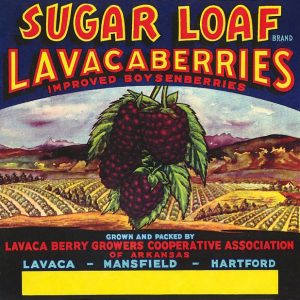calsfoundation@cals.org
Lavacaberry
The Lavacaberry is a hybrid variety of berry that takes its name from the town of Lavaca (Sebastian County), where it was planted extensively in the 1940s. The introduction of the berry to the town helped reinvigorate the local economy at a time when the effects of the Depression were still being felt.
In 1937, the Lavaca School District hired Idus H. Fielder as a vocational instructor. In his eagerness to help local growers, Fielder met Ed Girard, a local farmer, to discuss the plight of the farmers. After listening to Girard and others, Fielder remembered a berry from the farm of R. E. Hallett in McRae (White County). The berry was known as a “California Red Raspberry,” and Hallett had purchased his original six plants from a farm in Burbank, California, in 1927.
After the visit to the farm, Girard, Fielder, and their wives contracted for 1,000 plants, which he planted on one acre in the spring of 1938. The local soil was perfect and grew lush, hardy plants. He grossed 100 to 200 crates of berries and quickly sold them to Rouw and Spencer Produce Company in Van Buren (Crawford County), receiving about six cents a quart or $1.50 a crate. News of his success spread quickly, and other farmers began buying the plants from Girard to plant on their own farms. From his initial investment of 1,000 plants, Girard expanded to more than 300 acres.
Lavaca’s first berry shed was located on the northeast corner of the Lavaca School campus, where the berries were weighed and the farmers paid. In the height of berry season, workers would occasionally work into the early daylight hours. On one day in 1943, over 15,125 crates of berries weighing in at over 600,000 pounds passed through the shed. In 1946, the year the Lavaca Berry Growers Association was formed, the price went up to a record nineteen cents a pound and $20 apiece for 1,000 plants, which were sold to local growers.
In the spring of 1944, Professor Cooper and J. E. Vaile of the Agriculture Experiment Station in Fayetteville (Washington County) were asked to identify the berry that the Sebastian County farmers had been growing in order that the farmers might establish a higher ceiling price. The berries were sold at Camp Chaffee as raspberries in 1943. The buyers, however, insisted that it was a blackberry and should be sold at a lower price than the raspberries. Vaile and Cooper knew the berry in question was not a raspberry but that it was unusual and an unknown variety. They described it as a “phenomena” brand. The berry was similar but more vigorous and productive than the true blackberry. In 1948, after comparing the Lavaca to samples from the original California berries and the Logan—a blackberry-raspberry hybrid cross—the principal pomologist at the U.S. Department of Agriculture announced that the Lavaca was a synonym of boysen and, therefore, closely related to the boysenberry. Not being able to establish the correct variety of the berry, the berry growers themselves gave it the name Lavacaberry.
The cooperative planning and marketing of the Lavacaberry allowed the growers to concentrate on the harvest, knowing that the price they would receive had been set in advance. Lavacaberries were packed, shipped, and sold to grocery stores all over the country under the “Sugar Loaf” brand. A pamphlet was enclosed in each berry crate that contained recipes for Lavacaberry cobbler, shortcake, and punch.
In the late 1950s, larger growers from out of state contracted to sell berries to local stores, driving the market down and making the berries unprofitable. The shed closed in 1958–59 as the price of berries began to drop, and one by one, the growers plowed their berries up. The Lavaca Berry Growers Association met on December 15, 1977, at the Lavaca School cafeteria to sell the berry shed and property. The members also decided that the funds earned from the sale would be returned to the members of the association who sold berries through the association in 1949—the people who provided the money to purchase the land on which the original berry shed was located.
The patches dwindled slowly. The acres of berry fields have been replaced by subdivisions and modern businesses. Today, small, scattered patches exist in family gardens in and around Lavaca.
For additional information:
Green, Woody, and Jerry Wilson. “The LavacaBerry Story.” N.p.: 1988.
James, Jack. The History of Lavaca, Arkansas: Military Road, Oak Bower and Beyond. Lavaca, AR: 2007.
“The LavacaBerry.” Charleston Express, May 29, 1980, p. 5.
Jack James
Lavaca, Arkansas





Enjoyed these memories! I’ve lived in or around Lavaca my entire sixty-seven years.
My grandfather, George Hormann, lived in Wye (Pulaski County). He had several rows of Lavaca berries, planted in rows on wires supported by wood posts about every six to eight feet. I remember the berries as being larger than any berries I had ever seen, or have seen since. They were delicious!
Whenever I mention them to anyone, they act like I must have dreamt it. Well, I am happy to learn that this WASN’T a figment of my childhood fantasies. Grandpa George also grew HUGE watermelons, peanuts, and potatoes. We lived in Borger, TX, and my summertime vacations in Arkansas are some of my happiest memories.
Now that I know the berry really exists, I am going to find a source for plants. Then I am going to search for a friend here in New Mexico who has a little extra space in their garden.